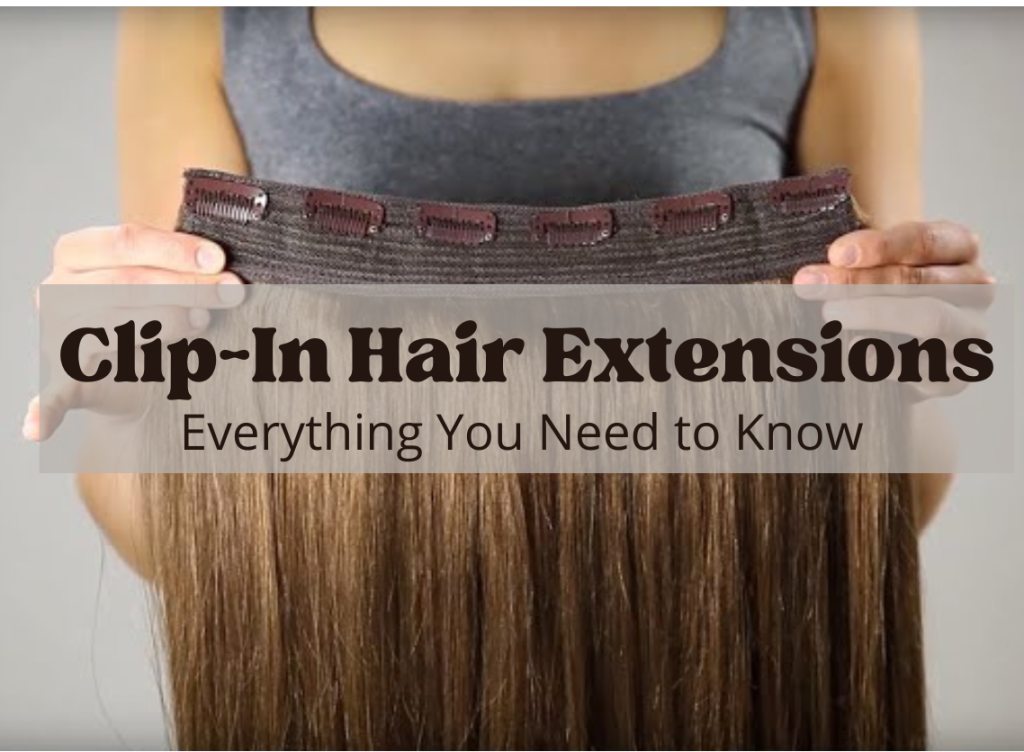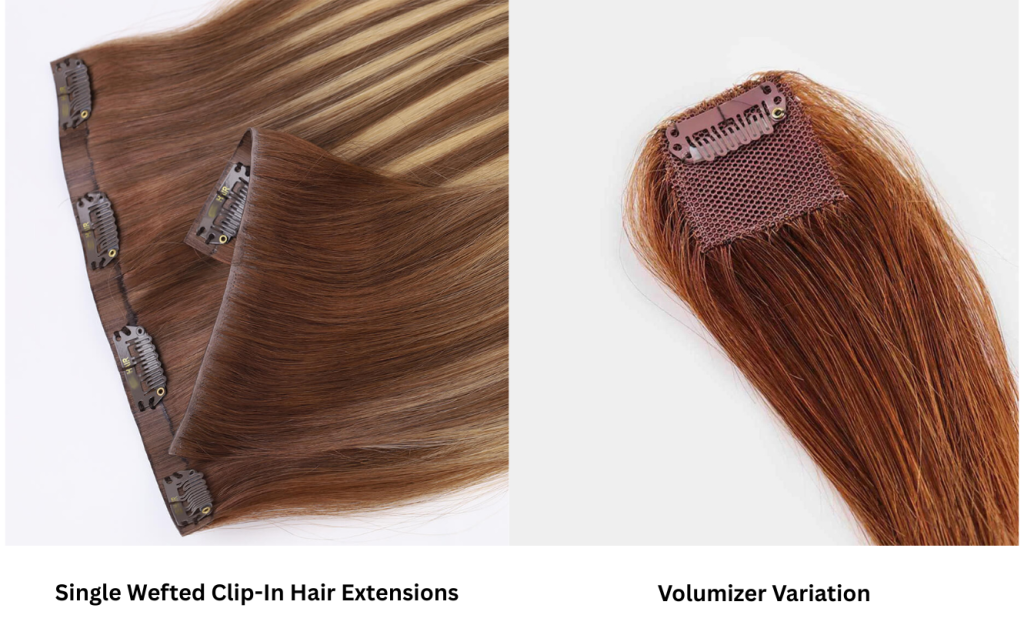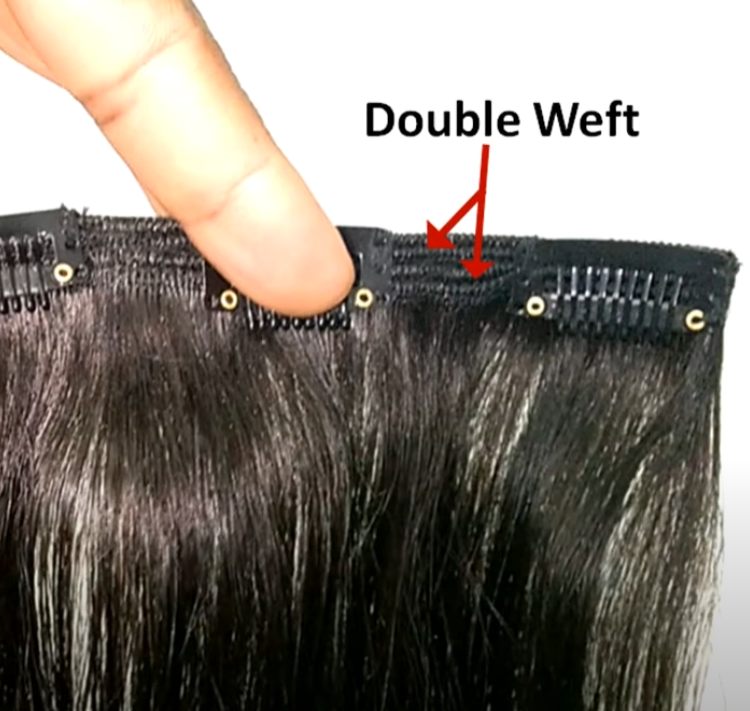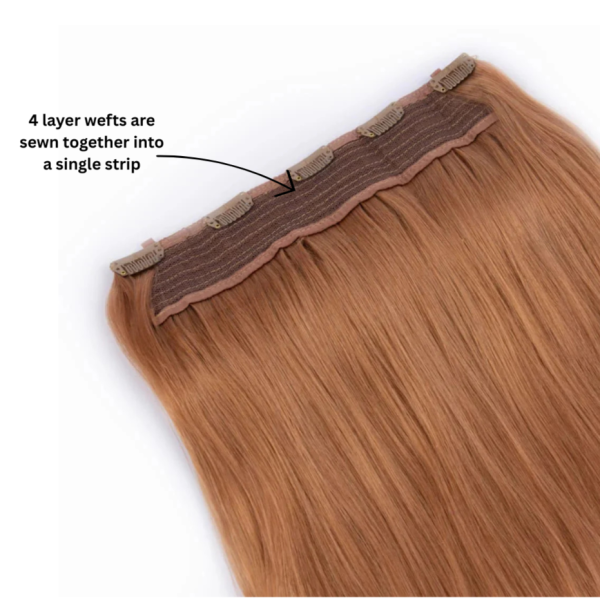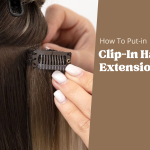Hair Knowledge
Clip-In Hair Extensions: Everything You Need to Know
Clip-in hair extensions are one of the most popular types of hair extensions today thanks to their convenience, ease of use, and lack of damage to real hair. This is an ideal choice for those who want to add thickness or length to their hair without the need for permanent extensions such as tape-in or keratin bond.
1. What Are Clip-In Hair Extensions?
1.1 Definition
Clip-in hair extensions are temporary, non-invasive hairpieces designed to add length, volume, or color to natural hair without permanent bonding or professional application. Each piece is equipped with small pressure-sensitive clips that can be easily attached and removed at home.
This type of hair extension is especially popular among first-time users, salon clients seeking a non-committal solution, and professional stylists looking for versatility in hairstyling.
1.2 Key Features of Clip-In Hair Extensions
Clip-in hair extensions are known for their convenience, versatility, and minimal commitment — making them a popular choice for both end-users and salon professionals across Europe. Here’s an in-depth look at the standout characteristics that make clip-ins an essential product in the modern hair extension market:
Temporary Yet Effective
Clip-ins are designed for short-term wear, allowing users to instantly change their hairstyle for a special occasion, photo shoot, or daily use — then easily remove them before sleep. This non-permanent nature helps avoid long-term damage to the natural hair.
Easy to Apply and Remove
Thanks to the integrated snap clips, users can install or remove a full set of extensions within 5–10 minutes, without professional help. This is particularly valuable for customers who prefer at-home solutions or for stylists working with time-limited appointments.
No Damage to Natural Hair
Unlike glue-ins, sew-ins, or tape-ins, clip-ins require no adhesive, heat, or braiding, which means the user’s scalp and hair strands are not exposed to stress or chemical residue. This makes clip-ins ideal for clients with sensitive scalps or thin, fragile hair.
Reusable and Cost-Effective
High-quality clip-in sets made from 100% Remy human hair can be reused for several months with proper care. This makes them a more sustainable and economical choice compared to single-use or semi-permanent extensions.
Versatile Styling Options
Clip-ins can be curled, straightened, braided, or styled in updos — just like natural hair. They offer flexibility for clients who want to experiment with new looks without committing to a permanent change.
Ideal for Fine or Short Hair
Thanks to their design and placement flexibility, clip-in extensions can blend seamlessly with even the shortest or finest hair types. They provide immediate volume at the roots and length throughout the body of the hair.
Travel-Friendly and Low Maintenance
They don’t require any special tools or salon visits after the initial purchase. For salon owners, this means lower client dependency on repeat maintenance appointments — and for end-users, it’s the ultimate solution for effortless beauty on the go.
These extensions are a go-to choice for customers who want flexibility and ease of use without sacrificing a natural appearance.
2. Construction of Clip-In Hair Extensions
2.1. Basic Components
A full set of clip-in hair extensions usually consists of multiple wefts (strips of hair) in various widths. These are attached to snap clips, which are sewn into the top seam of each weft. The number and size of the wefts vary depending on the desired coverage and fullness.
Clip Mechanism
At the core of every clip-in extension is the snap clip — a small, flexible, and secure metal piece sewn onto the weft. These clips are typically:
- Silicone-lined: to protect the scalp and prevent slippage
- Pressure-sensitive: they bend to open and snap flat to lock securely onto the natural hair
- Rust-resistant and lightweight: ensuring comfort for all-day wear
Each clip is stitched into the hair weft using reinforced thread to prevent tearing during repeated use. High-end products use stainless steel or hypoallergenic clips to suit clients with sensitive skin or allergies.
Hair Weft and Stitching
The hair in clip-in extensions is sewn into horizontal wefts, often double-stitched for strength and longevity. Wefts may come in varying widths (from 2-inch to 8-inch pieces) depending on their placement — sides, back, or crown.
Manufacturers like N Hair Factory typically offer two wefting styles:
- Single weft: lightweight and natural, best for fine hair
- Double weft: thicker and fuller, ideal for adding volume
The stitching technique plays a vital role in how natural the extensions look when worn. Machine wefting is most common, but hand-tied wefts are available for premium products, offering a flatter, more seamless finish.
2.2. Number of Pieces per Set
Clip-in sets usually include 7 to 10 weft pieces, with each set designed to provide balanced coverage:
| Piece Width | Placement Area |
| 8-inch (4 clips) | Center-back (widest) |
| 6-inch (3 clips) | Upper-back |
| 4-inch (2 clips) | Side or crown |
| 2-inch (1 clip) | Temples |
Sets are customizable, which is particularly helpful for EU salon clients who want bespoke lengths or density per region.
2.3. Weight and Thickness Options
The total weight of a clip-in set can range from 100g to 220g, depending on the desired look:
- 100g–120g: for natural volume (suitable for fine hair)
- 160g–180g: for medium thickness
- 200g–220g: for dramatic volume or blending with thick natural hair
Stylists may recommend different weights based on a client’s base hair density and the desired transformation.
3. Types of Clip-In Hair Extensions
Clip-in extensions are designed in a variety of structures to suit every need, from creating length, thickness, to temporary styling. Below are the most popular types, classified by structure:
3.1. Full Head Clip-In Hair Extensions
Definition
Full Head Clip-In Hair Extensions are a complete set of wefts designed to cover the entire head, adding volume and length instantly. The set typically consists of multiple individual hair pieces, each attached to small, discreet metal clips. These wefts vary in width, ranging from narrow strips for the sides and crown to wider wefts for the back of the head. When applied in the correct order, they blend seamlessly with natural hair, creating a fuller and longer hairstyle without the need for heat, glue, or salon visits. Visually, a full head set resembles a collection of fine, layered strips of hair, tailored to fit the shape and size of each section of your scalp.
Characteristics & Structure
- A standard full head set usually includes 7 to 10 wefts:
- 1–2 wide wefts (with 4–5 clips) for the back of the head
- 2–3 medium wefts (with 2–3 clips) for the sides
- 2–4 small wefts (with 1–2 clips) for the crown or filler areas
- 1–2 wide wefts (with 4–5 clips) for the back of the head
- Each clip is lined with a soft silicone strip that grips securely while protecting the scalp from damage or discomfort.
- This type of extension is ideal for anyone looking to quickly and easily enhance their hairstyle for special occasions or everyday wear. It’s especially beginner-friendly, making it a popular choice for first-time users.
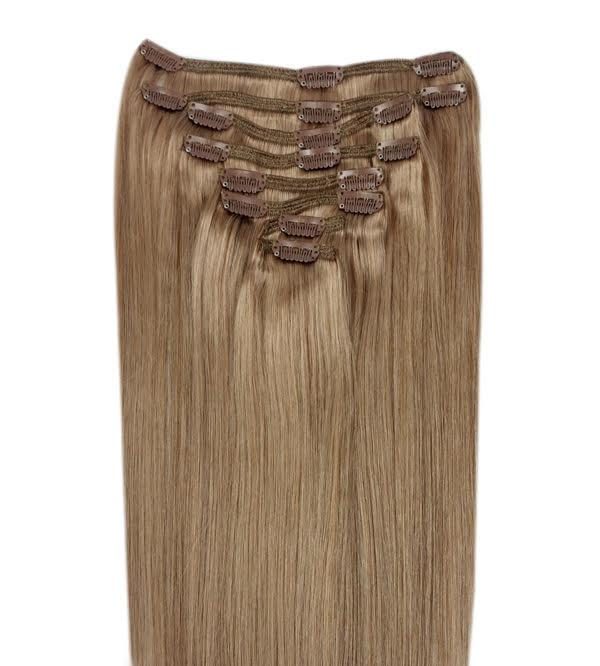
3.2. One-Piece (Single Wefted) Clip-In Hair Extensions
Definition
One-Piece Clip-In Hair Extensions, also known as single wefted clip-ins, consist of a single, wide hair weft with clips attached along the top edge. Designed for quick and easy application, this extension can add moderate volume and length in just one step—perfect for users seeking a fuss-free solution.
Characteristics & Structure
- Single continuous weft—usually 8 to 12 inches wide—spans across the back of the head from ear to ear.
- Fitted with multiple clips (typically 5–7) evenly spaced along the weft for secure and even placement.
- Best suited for those with thin to medium hair density, offering a natural-looking enhancement without feeling too heavy.
- Designed for convenience and speed, making it ideal for first-time users or those looking to update their look on the go.
- Can be layered with additional wefts for a more dramatic look, but often used alone for subtle, everyday volume.
Volumizer Variation
Volumizer clip-ins are a subtype of one-piece extensions, crafted with denser hair on a single weft. They are perfect for enhancing body and thickness, especially at the crown or back. Volumizers are often used in combination with other clip-ins, or alone for a natural boost without adding length.
3.3. Double Wefted Clip-In Hair Extensions
Definition
Double Wefted Clip-In Hair Extensions are hair pieces constructed by sewing two wefts of hair together—stacked one on top of the other—to form a single, thicker strip. Visually, they appear fuller and denser than standard single wefts, yet retain the same width. These are ideal for clients who want added volume without applying more individual pieces. When clipped in, they provide a lush, voluminous look with fewer attachment points, making the installation faster and more comfortable.
Characteristics & Structure
- Each double weft features two wefts sewn together, doubling the hair density while keeping the same number of clips.
- Commonly available in full head sets or as supplemental pieces to boost volume in specific areas.
- Ideal for medium to thick natural hair, as it blends easily without appearing too bulky.
- Despite the increased thickness, the base remains flexible and lightweight due to careful stitching and use of soft, skin-safe clips.
- This construction reduces the need for multiple layers, offering a fuller result with fewer wefts—perfect for salon clients seeking both volume and convenience.
3.4. Quad Weft Clip-In Hair Extensions
Definition
Quad Weft Clip-In Hair Extensions are a thick, voluminous option where four wefts of hair are sewn together into a single strip. This design allows users to achieve full coverage and dramatic volume with fewer pieces, making it quicker and easier to install while minimizing the feeling of bulk.
Characteristics & Structure
- Comprised of four wefts sewn horizontally into one compact piece. This layered construction delivers maximum density in a single strip.
- Despite the added volume, the quad weft is crafted to lie flat against the head, maintaining comfort and discretion.
- Ideal for those with medium to thick natural hair who want to enhance both length and volume without attaching multiple wefts.
- Usually requires only a few wefts (2–3 pieces total) to achieve a full-head transformation.
Each quad weft is equipped with multiple sturdy clips across the width to provide strong grip and support.
3.5. Seamless (Invisible) Clip-In Hair Extensions
Definition
Seamless or Invisible Clip-In Hair Extensions are designed for ultra-discreet wear. These extensions use a thin, flat silicone or polyurethane weft base instead of traditional stitched fabric, making them lay flatter against the scalp. When worn, they appear virtually undetectable—even in fine or thin hair—due to their smooth, translucent band that blends into the natural hairline seamlessly.
Characteristics & Structure
- Constructed using a thin silicone or PU strip as the weft base, which mimics the appearance of a natural scalp.
- Extremely flat and lightweight, reducing bulk at the roots and ensuring maximum comfort.
- Ideal for those with fine or thin hair who need a discreet, undetectable extension solution.
- Each piece comes with high-quality, skin-friendly clips securely attached along the base, ensuring a strong grip without damage.
- Because of the flat structure, seamless clip-ins are especially popular among European clients seeking a refined, polished look without visible attachments.
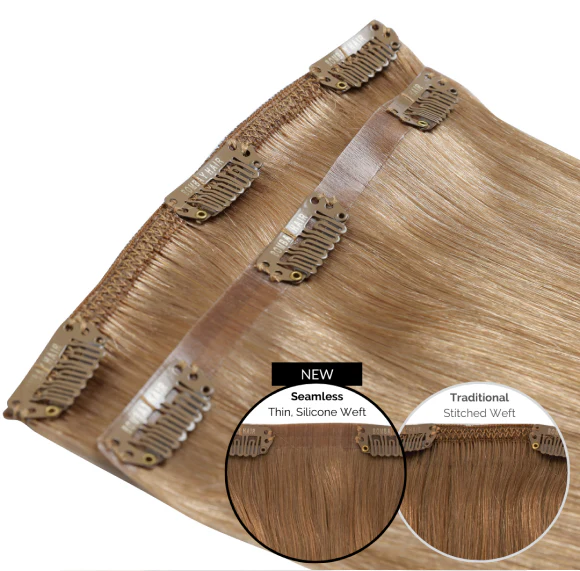
3.6. Ponytail Clip-In Hair Extensions
Definition
Ponytail Clip-In Hair Extensions are pre-styled hairpieces designed specifically to wrap around your natural ponytail. Shaped like a long, narrow weft with an attachment clip or comb and a wrap-around section, they instantly enhance the length, volume, and thickness of your ponytail—creating a sleek, full look in seconds.
Characteristics & Structure
- Pre-formed structure that mimics the look of a naturally thick ponytail.
- Typically features a comb or claw clip that anchors into your own ponytail base, plus a wrap-around strand with Velcro or tie to conceal the base and create a seamless finish.
- Available in various lengths (usually 14” to 26”), textures (straight, wavy, curly), and densities to suit different styles.
- Ideal for updos, high ponytails, low buns, or braided styles, adding elegance and drama to both everyday and special occasion looks.
- Heat-resistant variants allow for light styling, although pre-styled versions are common for ease of use
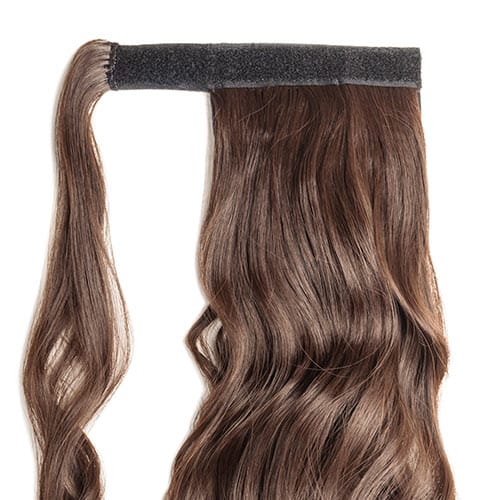
3.7. Bangs Clip-In Hair Extensions
Definition
Bangs Clip-In Hair Extensions are small, ready-to-use hairpieces designed to mimic natural fringe or bangs. They typically cover the forehead area and blend into the front of your existing hair. Most are shaped like a triangle or crescent with longer side strands that taper toward your temples, creating a natural face-framing effect.
Characteristics & Structure
- Easy-to-attach clip mechanism—usually two to three clips positioned on the base—to secure the bangs firmly in place.
- Come in various styles: blunt bangs, side-swept, curtain bangs, or wispy fringe.
- The base of the piece is crafted to sit flat against the scalp, ensuring a seamless blend.
- Ideal for users who want to experiment with bangs without committing to a permanent cut.
- Can be trimmed and styled to suit face shapes and preferences.
- Lightweight and breathable, suitable for daily use or temporary styling for events.
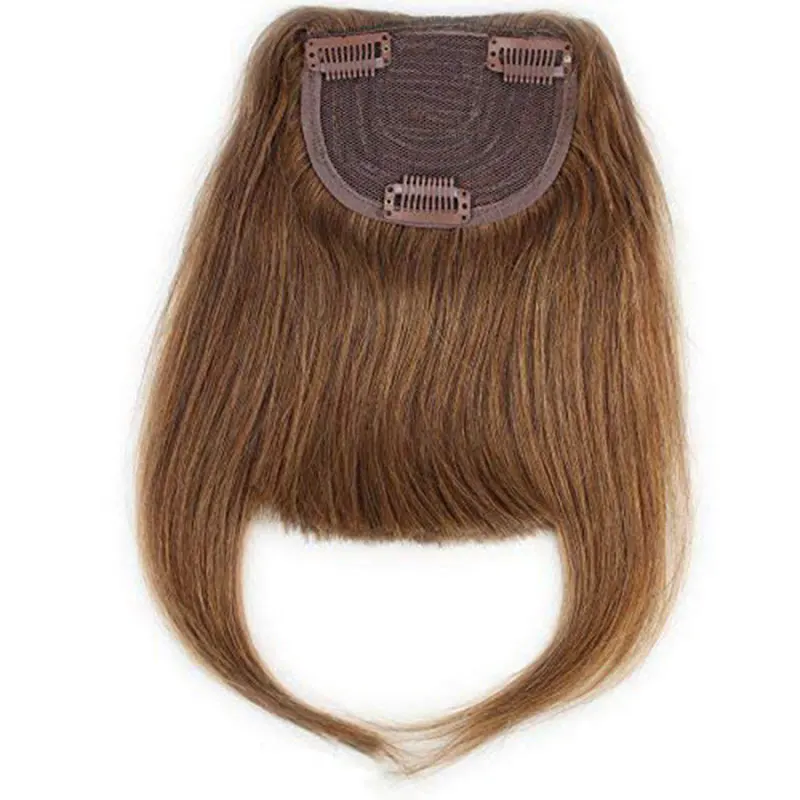
4. The Clip-In Hair Extension Production Process
4.1. Steps in Making Clip-In Hair Extensions
Creating a high-quality set of clip-in hair extensions requires meticulous craftsmanship, proper technique, and premium materials. The standard manufacturing process typically includes the following steps:
1. Hair Selection & Preparation
- Hair sourcing: The most commonly used type is Remy human hair, where all cuticles are aligned in the same direction to reduce tangling.
- Sanitizing & cleansing: The hair is thoroughly washed and sanitized to remove dirt, chemicals, or odors.
- Color processing (if needed): The hair is dyed to match specific shades using gentle processing to preserve texture and strength.
2. Weft Construction
- Hair strands are sorted by length and volume and evenly distributed along a sewn track (weft).
- A specialized sewing machine is used to stitch the hair tightly with double or triple stitching to ensure durability.
- For double wefted or quad weft extensions, multiple layers of hair are stacked and sewn together to add fullness.
3. Attaching Clips
- Metal snap clips are hand-sewn onto the wefts at evenly spaced intervals.
- Most clips are lined with silicone padding to provide a strong grip without damaging natural hair.
Clip placement is strategically aligned to ensure a balanced and comfortable fit on the head.
4.2. Common Sewing Techniques for Clip-In Extensions
| Weft Type | Sewing Method | Key Characteristics |
| Single Weft | 2-line machine stitching | Lightweight, ideal for fine hair |
| Double Weft | Two wefts sewn together | Thicker, more volume |
| Quad Weft | Four stacked wefts | Extra thick, requires strong stitching |
| Seamless/Invisible | Bonded to a thin PU strip | Lightweight, discreet finish |
4.3. Pro Tips for Producing Clip-In Extensions
- Even hair distribution: Ensure equal hair density along the weft to prevent imbalance or pulling on one side.
- Clean finishing: Trim the root ends neatly after sewing to avoid frizz or visible stubs.
- Test clip strength: Clips should have the right amount of tension—firm enough to stay in place but gentle on the scalp.
- Color consistency: Always double-check color tones under natural light to ensure harmony across all wefts.
- Secure weft ends: For premium orders, apply specialized adhesive at both ends of the weft to prevent unraveling.
5. How to Use Clip-In Hair Extensions & Important Application Tips
5.1. How to Use Clip-In Extensions: Step-by-Step
Clip-in extensions are designed for ease and flexibility, making them an ideal option for both professionals and individuals at home. Here’s a general guide on how to apply them properly:
First: Prepare Your Natural Hair
- Start with dry, tangle-free hair.
- Use a tail comb to create horizontal partings, starting from the nape and moving upwards.
- Lightly tease the roots of each section (optional) to give clips extra grip.
Next: Clip in the Extensions
- Begin with the widest weft and secure it at the lower part of the head.
- Snap the middle clip first, then the side clips.
- Repeat with narrower wefts as you move upward, blending naturally with your own hair.
- For side pieces or bangs, position them closer to the front.
Final: Blend and Style
- Use a soft brush or fingers to blend the extensions with your own hair.
- If needed, lightly curl or straighten both your natural hair and extensions together to create a uniform look.
5.2. Tips for a Seamless and Comfortable Application
- Avoid attaching too close to the scalp: Leave a small gap to avoid tension and pulling.
- Don’t overload: Only apply as many wefts as you need. Too many can feel heavy or unnatural.
- Angle the clips properly: Especially around the face, clip at a slight angle to follow your hairline.
- Use a mirror check: View from different angles to ensure no clips are exposed.
- Trim after application: For a perfectly blended look, consider trimming the extensions while they’re clipped in.
5.3. Special Notes for Salon Use
- For professional applications, it’s common to customize the clip-in layout based on the client’s head shape and hair volume.
- Color-matching and texturing the extensions during installation can elevate the final result.
- Keep a sanitized set of tools and clips ready, especially if reusing extensions across clients (not recommended unless it’s their personal set).
6. How to Care for and Maintain Clip-In Hair Extensions
Proper care ensures your clip-in extensions stay beautiful, tangle-free, and long-lasting — especially when made from high-quality human hair. Here’s a complete guide for both daily and long-term maintenance:
6.1. Washing Your Clip-Ins
Clip-in extensions don’t need to be washed as frequently as natural hair — usually after 10–15 wears or when there’s noticeable product buildup.
How to Wash:
- Detangle first: Use a wide-tooth comb or a loop brush to remove tangles.
- Fill a basin with lukewarm water and add a sulfate-free, moisturizing shampoo.
- Gently swish the extensions in water — avoid rubbing or twisting.
- Rinse thoroughly, then apply a hydrating conditioner, focusing on mid-lengths to ends.
- Leave in for 5–10 minutes, then rinse with cool water.
Pro Tip: Avoid soaking the clips in water for too long to prevent rust or loosening.
6.2. Drying the Hair
- Gently squeeze out water using a microfiber towel — do not wring or twist.
- Lay flat on a clean towel and let air dry completely.
- If using a blow dryer, apply a heat protectant first and use a cool or low-heat setting.
6.3. Brushing and Daily Maintenance
- Always brush before and after use with a soft bristle brush or loop brush designed for extensions.
- Hold the top of the weft as you brush to avoid unnecessary stress on the hair.
- Avoid brushing when wet — detangle using fingers or a wide-tooth comb instead.
6.4. Storage Tips
- Store in a silk or satin bag, original box, or on a clip-in hanger to keep them dust-free and tangle-free.
- Make sure they’re 100% dry before storing to avoid mold or odor.
- Keep away from direct sunlight or humid environments.
6.5. Long-Term Care Advice
- Use leave-in conditioners or hair serums sparingly to maintain softness and shine.
- Avoid overusing heat styling tools — excessive heat shortens the life of the extensions.
- For dyed or color-treated extensions, use color-safe products only.
7. Some FAQs about Clip in Hair Extensions
7.1. Are Clip-Ins Safe for Natural Hair?
Yes — when used and maintained correctly, clip-in hair extensions are among the safest methods of adding length and volume. Unlike semi-permanent extensions, clip-ins:
- Don’t involve glue, heat, or chemical adhesives.
- Can be removed daily, allowing your natural hair to rest.
- Pose minimal risk of damage when clipped and brushed properly.
However, overuse or improper application (such as placing clips in the same spot repeatedly or wearing them during sleep) may cause tension or breakage over time. The key is gentle handling and rotation of placement.
👉Read more: Clip-In Extensions: Are They Bad for Your Hair? Care Tips Included
7.2. Who Should Use Clip-In Hair Extensions?
Clip-in extensions are extremely versatile and ideal for a wide range of users — particularly those who want flexibility without committing to a permanent look. They are best for:
- Beginners in Hair Extensions: Perfect for first-time users learning how to wear and style extensions.
- People Who Want Temporary Glam: Ideal for weddings, photoshoots, events, or holidays — apply when needed and remove when done.
- Clients Who Prefer Low-Maintenance Options: Clip-ins require minimal daily upkeep compared to tape-ins or bonded methods.
- Those with Healthy or Medium-Density Hair: For best blending, users should have enough natural hair to cover the wefts and avoid noticeable separation. However, seamless clip-ins or volumizing sets can work well even on finer textures.
7.3. When to Avoid Clip-Ins
While clip-ins are generally gentle, they might not be suitable for:
- Severely thinning or fragile hair, where clip pressure could cause damage.
- Alopecia or scalp sensitivity, unless using specially designed lightweight pieces.
- Long-term everyday use without breaks, as this may strain natural roots.
In these cases, halo extensions or toppers may be better alternatives.
Conclusion
Clip-in hair extensions are a game-changer for those who want instant volume, length, and styling versatility — without long-term commitment or damage to natural hair. Whether you’re a first-time user exploring hair extensions or a salon owner guiding clients through their options, clip-ins offer a safe, user-friendly, and cost-effective solution.
From understanding their structure and types to learning how they’re made and how to care for them, this guide gives you everything you need to make informed decisions about clip-in extensions. And with the right supplier, like N Hair Factory, you can ensure each set is crafted to meet both professional standards and customer satisfaction.
Ready to elevate your styling game or salon offerings? Explore our range of high-quality clip-in hair extensions — designed for beauty, built to last.
💡Maybe you interested in: What you need to know to choose the right clip-in hair extensions
Related articles:
Can You Swim with Clip-In Hair Extensions?
Can You Sleep with Clip-In Hair Extensions?
How to Put in Clip-In Hair Extensions
How to Choose Clip-In Hair Extensions For Thin Hair

